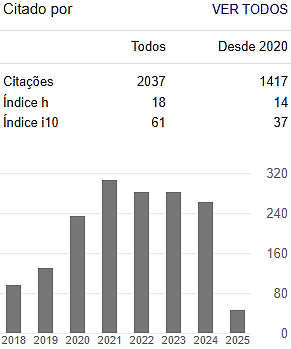Effects of straw and herbicide application in the cowpea culture
Keywords:
Straws; weed community; Vigna unguiculata.Abstract
The objective of this research was to evaluate the yield of the cowpea crop, when grown on cover crops straws, managed or not with herbicides applied in post-emergence. The experiment was conducted in the field, in a complete randomized block design with three replications. In a 5x2 factorial scheme, five types of straw were tested: sorghum, ruziziensis grass, tanzania grass, marandu grass and weeds. The second factor was characterized by the absence and application of the ready mix of bentazone + imazamoxi at the dose 600 + 28 g ha-1 at 13 days after emergence and the herbicide haloxifope-p-methyl at the dose of 62.35 g ha- 1 to 18 DAE. Weed density and dry mass were evaluated at 20 and 85 DAE of the crop, plant height (AP), stem diameter, chlorophyll content, dry mass of stem, flowers, pods, leaves and aerial part and the leaf area in the flowering of the crop (46 DAE). At harvest, the production components were evaluated: number of grains per pod, number of grains per plant, weight one hundred grains, the population of cowpea plants and grain yield. The straws of grass-ruziziensis, grass-tanzania and grass-marandu on the soil surface reduce the dry mass of weeds, constituting necessary management where chemical control has not been carried out. Regardless of the use of straw, the application of the herbicide is essential to guarantee the productivity of the crop. The cultivation of cowpea on sorghum straw, ruziziensis grass, tanzania grass and marandu grass results in higher grain yield.
Downloads
References
BRAZ, A.J.B.P.; PROCÓPIO, S.O.; CARGNELUTTI FILHO, A.; SILVEIRA, P.M.; KLIEMANN, H.J.; COBUCCI, T.; BRAZ, G.B.P. Emergência de plantas daninhas em lavouras de feijão e de trigo após o cultivo de espécies de cobertura de solo. Planta daninha, v.24, n.4, p.621-628, 2006.
CONAB, CNDA. Acompanhamento da safra brasileira: grãos. V. 5 - Safra 2017/18 - N. 11 - Décimo levantamento, Agosto 2018, 2019. Disponível em: https://www.conab.gov.br/info-agro/safras/graos/boletim-da-safra-de-graos;, Acesso em: 23 junho 2019.
CORRÊA, M.J.P.; ALVES, G.L.; ROCHA, L.G.F.; SILVA, M.R.M. Períodos de interferência de plantas daninhas na cultura do feijão caupi. Revista de Ciências Agroambientais, v.13, n.2, 2016.
CORREIA, N.M.; DURIGAN, J.C.; KLINK, U.P. Influência do tipo e da quantidade de resíduos vegetais na emergência de plantas daninhas. Planta Daninha, p.245-253, 2006.
DAMASCENO, L.A. Produtividade do milho em sucessão a plantas de cobertura de solo. p.69, Tese (Doutorado em Agronomia Tropical). Universidade Federal do Amazonas, Manaus-AM 2019.
FREIRE FILHO, F.R.; RIBEIRO, V.Q.; ROCHA, M.M.; SILVA, K.J.D.; NOGUEIRA, M.S.R; RODRIGUES, E.V. Feijão-caupi no Brasil: produção, melhoramento genético, avanços e desafios. Embrapa Meio-Norte-Livro científico (ALICE), 2011.
FREITAS, F.C.L.; MEDEIROS, V.F.L. P.; GRANGEIRO, L.C.; SILVA, M.G.O.; NASCIMENTO, P. G. M. L. e NUNES, G. H. Interferência de plantas daninhas na cultura do feijão-caupi. Planta Daninha, v.27, n.2, p 241-247, 2009.
GARCIA, C.M.P.; ANDREOTTI, M.; TEIXEIRA FILHO, M.C.M.; LOPES, K.S.M.; BUZETTI, S. Decomposição da palhada de forrageiras em função da adubação nitrogenada após o consórcio com milho e produtividade da soja em sucessão. Bragantia, v.73, n.2, p.143-152, 2014.
GOMES, D.S.; BEVILAQUA, N.C.; SILVA, F.B.; MONQUERO, P.A. Supressão de plantas espontâneas pelo uso de cobertura vegetal de crotalária e sorgo. Revista Brasileira de Agroecologia, v.9, n.2, p. 206-2013, 2014.
LIMA, S.F.; TIMOSSI, P.C.; ALMEIDA, D.P.; SILVA, U.R. Weed suppression in the formation of brachiarias under three sowing methods. Planta Daninha, v. 32, n. 4, p. 699-707, 2014.
MATOS, V.P.; SILVA, R.F.; VIEIRA, C.; SILVA, J.F. Período crítico de competição entre plantas daninhas e a cultura do caupi. Pesquisa Agropecuária Brasileira, Brasília, v.26, n.5, p.737-743, 1991.
NOCE, M.A.; SOUZA, I.F. de; KARAM, D.; FRANÇA, A.G.; MACIEL, G.M. Influência da palhada de gramíneas forrageiras sobre o desenvolvimento da planta de milho e das plantas daninhas. Revista Brasileira de Milho e Sorgo, v.7, n.03, 2010.
NUNES, U.R.; JÚNIOR, V.C.A.; SILVA, E.B.; SANTOS, N.F.; COSTA, H.A.O. e FERREIRA, C.A. Produção de palhada de plantas de cobertura e rendimento do feijão em plantio direto. Pesquisa Agropecuária Brasileira, v.41, n.6, p.943-948, 2006.
PEREIRA, L.S., JAKELAITIS, A.; OLIVEIRA, G.S.; SOUSA, G.D.; SILVA, J.N.; COSTA, E.M. Interferência de plantas daninhas em pastagem de Urochloa brizantha cv. Marandu. Revista Cultura Agronômica, v. 28, n. 1, p. 29, 2019.
PEREIRA, L.S. Eficiência de herbicidas aplicados em pós-emergência na cultura do feijão-caupi. 2019. Monografia 31p. (Curso de Bacharelado de Agronomia). Instituto Federal de Educação, Ciência e Tecnologia Goiano - Campus Rio Verde, GO, 2019.
RIBEIRO, V.Q.; JÚNIOR, A.S.D.; SANTOS, A.A.; SOBRINHO, C.A.; BASTOS, E.A.; MELO, F.B.; VIANA, F.M.P.; FILHO, F.R.F.; CARNEIRO, J.S.; ROCHA, M.M., CARDOSO, M.J.; SILVA, P.H.S. Cultivo do feijão-caupi (Vigna unguiculata (L.) Walp). Embrapa Meio-Norte-Sistema de Produção (INFOTECA-E), p.11-17, 2002.
SILVA, K.S; FREITAS, F.C.L.; SILVEIRA, L.M.; LINHARES, C.S.; CARVALHO, D.R.; LIMA, M.F.P. Eficiência de herbicidas para a cultura do feijão-caupi. Planta Daninha, v.32, n.1, p.197-205, 2014.
TIMOSSI, P. C.; DURIGAN, J. C.; LEITE, G. J. Formação de palhada por braquiárias para adoção do sistema plantio direto. Bragantia, v. 66, n. 4, p. 617-622, 2007.
TOKURA, L.K.; NÓBREGA, L.P. Potencial alelopático de cultivos de cobertura vegetal no desenvolvimento de plântulas de milho. Acta Scientiarum - Agronomy, Maringá, v.27, n.2, p. 287-292, abril/junho, 2005.
Downloads
Published
Issue
Section
License
Copyright (c) 2020 Colloquium Agrariae. ISSN: 1809-8215

This work is licensed under a Creative Commons Attribution-NonCommercial-NoDerivatives 4.0 International License.

